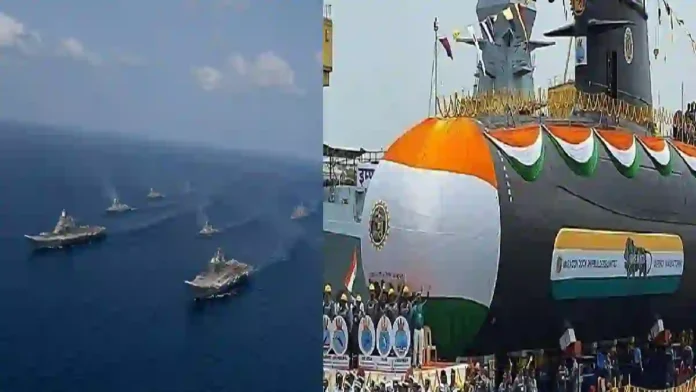The Indian Navy has laid out an ambitious expansion roadmap that seeks to transform it into a true blue-water force by 2035, with the objective of building and maintaining a fleet of more than 200 warships and submarines. This represents a significant scaling-up from its present strength of approximately 140 vessels, and reflects the urgent operational and strategic imperative to counter growing maritime challenges in the Indian Ocean Region (IOR).
India faces an increasingly contested maritime environment, with China steadily expanding its presence through carrier strike groups, nuclear-powered submarines, and overseas bases, while Pakistan is simultaneously working to modernise its own naval inventory, particularly its submarine fleet, aided by significant assistance from Beijing.
Read- DRDO And SAFRAN Combine To Give India Its First Jet Engine With 100% ToT
In this context, New Delhi recognises that a numerically stronger, technologically advanced, and networked naval force is vital not only for deterrence and conflict preparedness but also for maintaining dominance across its sea lines of communication (SLOCs) and ensuring access to global trade arteries.
At the heart of this long-term maritime capability plan is a strong emphasis on indigenous shipbuilding, in line with the Make in India and Atmanirbhar Bharat initiatives.
Currently, around 55 vessels are under construction at Indian shipyards, including both state-owned and private facilities, spanning a wide range of combatants such as frontline destroyers, stealth frigates, anti-submarine corvettes, and support platforms.
In addition to those under construction, the government has approved the development of another 74 platforms, ensuring a steady order pipeline for the next decade.
This dual-track approach of immediate construction combined with approved future programs guarantees that India’s naval expansion is structurally embedded in long-term force modernisation rather than being ad hoc in nature.
The strategy also creates economies of scale and sustains industrial capability, ensuring that design bureaus, shipyards, and ancillary suppliers are kept constantly engaged in warship and submarine construction.
Read- BrahMos-NG Supersonic Cruise Missile To Be Tested In 2026
Read- ‘In India, Land Will Remain Currency of Victory’: Army Chief General Upendra Dwivedi
The composition of this expansion is particularly tailored towards operational needs and regional threats. Diesel-electric submarines with advanced air-independent propulsion (AIP) systems form a key element, aimed at strengthening India’s undersea warfare capabilities against both Chinese nuclear submarines operating in the Indian Ocean and the incoming Chinese-supplied submarines destined for Pakistan.
Alongside submarines, stealth frigates and next-generation destroyers under Project 17A and Project 15B will significantly enhance surface strike and air-defence capabilities, providing layered protection to carrier battle groups while maintaining offensive firepower with long-range cruise missiles.
Anti-submarine warfare (ASW) corvettes and mine countermeasure vessels (MCMVs) are being prioritised to ensure sea-lane security, protect high-value units, and guarantee freedom of navigation in choke points such as the Strait of Malacca and the Persian Gulf approaches, where both conventional threats and asymmetric hazards like mines pose risks to shipping.
Beyond the sheer numerical expansion of vessels, the plan underscores the creation of a fully networked naval force capable of integrated operations across domains.
This includes investment in satellite-based communication links, unmanned aerial and undersea platforms, long-range maritime patrol aircraft, and data-fusion architectures that allow surface ships, submarines, and shore-based assets to operate seamlessly in real time.
Read- Police arrest 5 with ‘terror-module links planning blasts in Delhi-NCR, recover bomb material’
Such networking is essential for maritime domain awareness (MDA) in an era defined by high-tempo operations and multi-theatre challenges. By building a cohesive and layered defence and strike architecture, the Navy aims to create not just a fleet with superior numbers, but one that is technologically resilient, operationally flexible, and deeply integrated.
The strategic vision has important implications beyond the defence sphere as well. Expanding India’s naval shipbuilding requires the mobilisation of multiple domestic industries spanning steel, electronics, propulsion, weapon systems, and software integration.
By placing over 120 vessels in the pipeline through ongoing and approved projects, the Navy effectively positions shipbuilding as a cornerstone of India’s defence industrial base.
This is expected to generate significant employment opportunities, build technical expertise, and enhance economic activity in coastal states that host major shipyards. In the long run, this domestic production focus will reduce dependence on foreign designs and suppliers, giving India both operational autonomy and a potentially competitive export portfolio to offer friendly nations.
Ultimately, India’s naval expansion plan must be understood as a broader geopolitical statement as well as a national security necessity.
With China consolidating influence in the Indo-Pacific through initiatives like the Belt and Road-linked port construction and Pakistan attempting to deny India local maritime supremacy through submarine acquisitions, New Delhi’s decision to target a fleet exceeding 200 warships by 2035 demonstrates its intent to maintain freedom of operations in critical sea zones, safeguard growing overseas trade, and project power where national interests demand.
By employing indigenous production with a strategic force structure tailored to counter both conventional and asymmetric threats, the Indian Navy is preparing to emerge as a robust, globally relevant maritime power within the next decade.
IDN (With Agency Inputs)
Agencies




